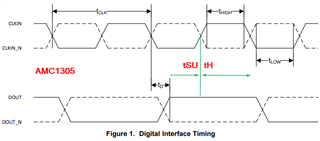Other Parts Discussed in Thread: AMC1305M05, AMC1305M25
Hi Team
Let me ask short question
a).Does AMC1106M05 have a Duty cycle clock limitation for external clock?(Ex:+/-10%)
b).The differential input resistance is 4.9 kΩ, but is it necessary to calculate the current value considering the combined resistance with the detection shunt R? (Combined resistance including input filter)
C) Do you have a recommended input filter for analog input?
best regards
TATSU



